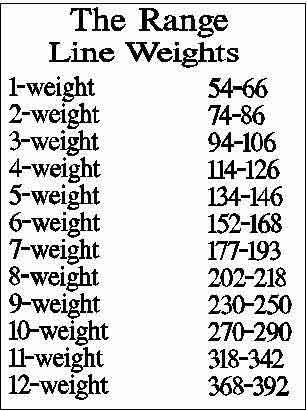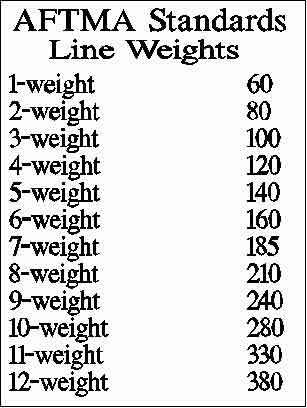Fly Fishing with Doug Macnair: All About Lines: Part 1©
Fly Fishing with Doug Macnair: All About Lines: Part 1©
From his manuscript, Fly Fishing for the Rest of Us
You may recall in the introduction, I mentioned my belief that it’s possible to have a fly fishing gestalt -- that happens when the fly fisher - coupled with the line, leader, rod and reel - become a system greater than the simple sum of the parts. If this happens to you, it’s apt to be "magic" of the fly line that’s doing more than its fair share of the work. I contend the fly line is the most important part of the fly fishing system, not the rod as many folks, who are into making money would argue. Now before jumping up and down in wild hysterics believing me to be a loony, allow me to set forth my case over the next several weeks. Who knows, you might be surprised, and even come over to my way of thinking.
Fortunately. I am not the only fly fisher to ever think this way. Lee Wulff, renowned master angler, fly fisher, writer and fly tier, argued this case in an earlier time. He proved as much in 1941 when he first hand-cast a fly line some 40 feet. In fact, Lee hooked, played and landed a 10-pound Atlantic salmon … without any rod at all! So much for rods. How about that school mates? While Lee is no longer with us, his wife, Joan, is , and is she something: Joan is a master fly fisher, fly caster and writer in her own right. She continues to run the Wulff fly fishing school, established, as I recall, back in 1979. Among her many credits, Joan received the Lifetime Contribution Award from the North American Fly Tackle Association (NAFTA), in 1995. It marked only the second time the award had been issued.
 Since Lee Wulff first argued the fly line was of primary importance in fly fishing, the proliferation in numbers and types of lines has been remarkable. Attribute the gains to the "Hi-Tech" capabilities developed in manufacturing. Scientific Anglers now offers somewhere around 450+ fly lines, while Cortland stands at 400+. Of course, this does not include the fly lines of Orvis, Teeny Nymph, RIO, Airflo, McKenzie, and/or Royal Wulff. Named specialty lines - such as Lazerline, WindMaster, Windcutter, Striper, and XRL - abound with new ones coming announced almost every day. As one fly fisher remarked, "We seem to have a fly line for every fly pattern." Later on, we will discuss a few of the new lines and how they might relate to you and your fly fishing "gestalt."
Since Lee Wulff first argued the fly line was of primary importance in fly fishing, the proliferation in numbers and types of lines has been remarkable. Attribute the gains to the "Hi-Tech" capabilities developed in manufacturing. Scientific Anglers now offers somewhere around 450+ fly lines, while Cortland stands at 400+. Of course, this does not include the fly lines of Orvis, Teeny Nymph, RIO, Airflo, McKenzie, and/or Royal Wulff. Named specialty lines - such as Lazerline, WindMaster, Windcutter, Striper, and XRL - abound with new ones coming announced almost every day. As one fly fisher remarked, "We seem to have a fly line for every fly pattern." Later on, we will discuss a few of the new lines and how they might relate to you and your fly fishing "gestalt."
The AFTMA Standards. At this point, it’s important to understand that the only standard in fly fishing applies solely to fly lines. In the old days, chaos reined: no standard existed for much of anything. Consequently, most folks were on different wave-lengths. Then one day, the folks in AFTMA (the American Fishing Tackle Manufacturers Association) got together and standardized line weights. This was (and is) a big deal -- for the first time fly fishers had something to rely on as a constant between makers and manufacturers.
Here's how the standards work. Lines are rated by the weight in grains contained in the first 30 feet of the line. Why 30 feet? In theory, it was agreed that 30 feet was a reasonable distance to initially load the rod during the cast. While I’ve included a chart of the actual AFTMA line weights, an easy way to derive a close approximation is to multiply 30 (standing for 30-feet) by the line weight on the package. Thus, estimating a 5-weight line at 150 grains (5 X 30) isn’t far removed from the correct AFTMA 5-weight standard of 140 grains.
In case you thought that rods are standardized in how they are rated, think again. The fact is, each manufacturer unilaterally decides which AFTMA rated line their rods optimally cast and rates them accordingly. Some rods, as you are probably aware, carry a dual rating such as 6/7 or 8/9. This suggests the rod casts both weights equally well. Maybe so and maybe not! And before you dial me out, think about this -- what’s good for Bull Moose is not necessarily good for you!
 Before we go further, I think it is important to understand some of the broad variables involved in line weight and line selection.
Before we go further, I think it is important to understand some of the broad variables involved in line weight and line selection.
The Weight Range. Even though the AFTMA standards have contributed much to making fly fishing what it today, consider this: All lines are not created equal. The manufacturing processes, while close to being perfect, are not. Machine and/or human error exist. Therefore, the AFTMA standards set an acceptable "range" for each line weight. It follows that as long as a line falls with the defined weight range, it meets the line weight requirements of the AFTMA standard. I’ve included a chart reflecting the range for each line weight. Importantly, your "gestalt" may depend on whether your line is "light" or "heavy" as it relates to the acceptable range!
It is quite possible for two fly fishers with identical 7-weight systems and similar casting techniques to experience variance in the accuracy, delicacy or distance achieved during their casts simply because one is using a "heavy" 7-weight line (193 grains) and the other, a "light" 7-weight line(177 grains). Wild thought, isn’t it? And just think -- the lines could come from the same manufacturer. If you don’t think 16 grains is a big deal, consider this: there is apt to be more than 30-feet of line in the air during the cast. Since weights are fixed only for the first 30 feet of the fly line, it shouldn't be hard to accept the notion that a "heavy" 7 tends to weigh more throughout its length than a "light" 7. Who knows the exact weight? I certainly don't. However, I do know that 50 or more feet of line in the air during the casting stroke weighs considerably more than you might suspect.
While we are on the subject of the weight range, note the difference between a light-7 and a heavy-6. It’s a mere 9 grains. That suggests you could expect little casting difference between the two. On the other hand, look at the whopping 41 grain difference between a light-6 and a heavy-7. With lots of line hanging out in the air, that could be a rod snapper. Importantly, these weight comparisons are much more than just numbers. The differences, both large and small, begin to explain some of the varying experiences, both good and bad, you are likely to encounter when fly casting.
Northlands or Tropics, Fresh Water or Salt. Fly line manufacturing technology has done all of us another good deed. There are now lines that account for the extremes of climate. Be sure to take advantage of this fact when selecting a line, be it for the tropics or cold waters of the north. A fly line made for optimum performance under a torrid sun in the warm salt waters of the Gulf is most apt not to be the right pick for fly fishing the cold waters off the coast of Maine. The line that fished so well in the Gulf becomes stiff with a coil-set difficult to straighten. Reverse the situation and the right line for northern water becomes a weak limp piece of noodle in the summer waters of the Gulf. Heat, warm saltwater and ultraviolet light are line killers.
All manufacturers now account for the differences in climatology and geographical conditions. For me, the saltwater of the Texas coast dictates a line selection form either Cortland’s 444 SL Saltwater series or Scientific Anglers’ Mastery Saltwater series. Inland, I like both SA’s freshwater Mastery series and Cortland’s 444 SL Lazerlines. Further north you might prefer SA’s Ultra or Cortland’s 444 SL. Other manufacturers offer similar descriptions to help you differentiate between lines when making your selection.
Near or Far. Some lines are fabricated to enhance the presentation of the fly while others try to maximize distance. Still others try for both. Because of you, the era of the "specialty" lines has arrived. For example, SA’s Mastery Bonefish is designed to accommodate both distance and presentation when chasing the elusive bonefish or permit in the clear waters of the Caribbean. Of course, that doesn’t mean the Bonefish isn’t a good choice for speckled trout and redfish along the Texas Coast -- it is. But whether you would do as well with the Mastery Bonefish instead of the Mastery Saltwater Taper, a different line, is a matter of individual differences. One or the other might result in a fly fishing gestalt.
Another example might be one of the Triangle Taper line from Royal Wulff. Initially considered by many to be a specialty line, the Triangle Taper has grown in popularity and is now the choice of many excellent casters. By the way, the saltwater version is an excellent performer. If the name Wulff sounds familiar, it should. Lee Wulff started the company well over a decade ago. Lee’s had the concept that a heavier line should always be turning over a lighter line during the cast. As you might expect, the Triangle Taper series has a long and progressive taper. In truth, most of the specialty lines will do more than one thing, and usually do it well.
Line Color. Would you believe it? The color of the line seems to be one of the driving forces in line selection. Accordingly, almost any color anyone could want is already available. Talk about putting the cart before the horse, do not follow this lead. The way a line performs is what is important and not its color. In making this statement I recognize the argument that the color of the line can be the deciding factor in whether or not the fish strikes. However, my discussions with a myriad of fish have failed to substantiate the claim. About the only thing I learned is that a fly fisher who throws a fly at a fish is most apt not to catch it, regardless of the line’s color. This makes sense to me -- after all, if you were a great big fish, how would like to be attacked by a vicious little fly? Frankly, I would be scared to death.
In summary, let me emphasize the importance of understanding the vagaries of line weights as well as the variables of climatology and geographical conditions when selecting a line. Part 2 of "All About Lines," will discuss the different types of fly lines available and offer a few more thoughts for you to consider when making a selection.
© Copyright: Douglas G. Macnair, 1997 - 2000.
|
